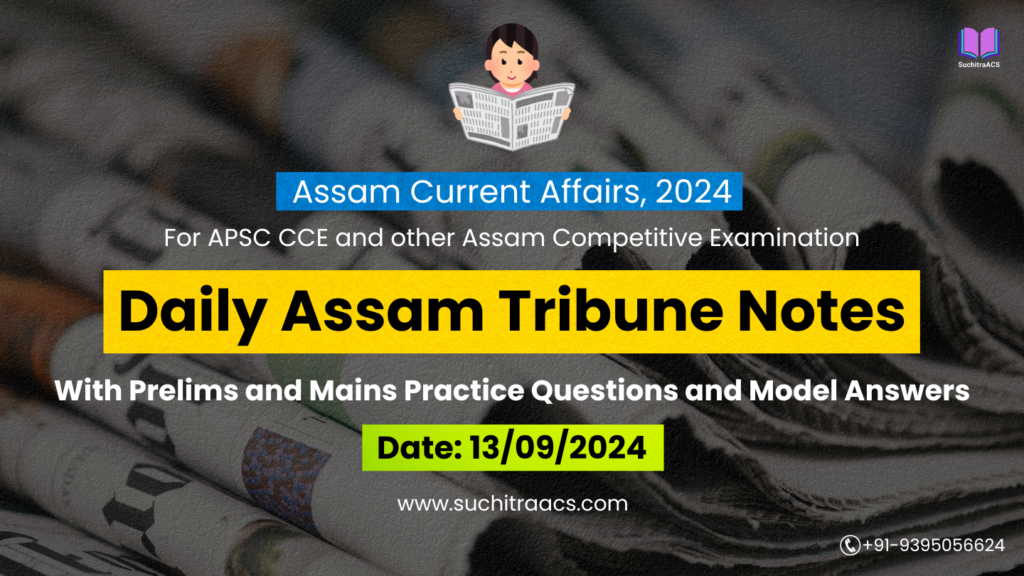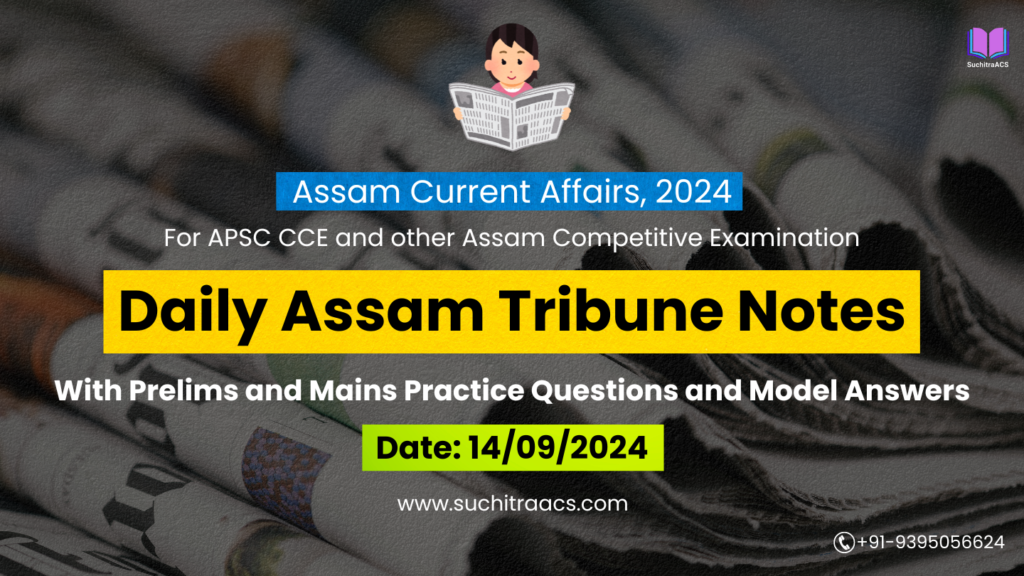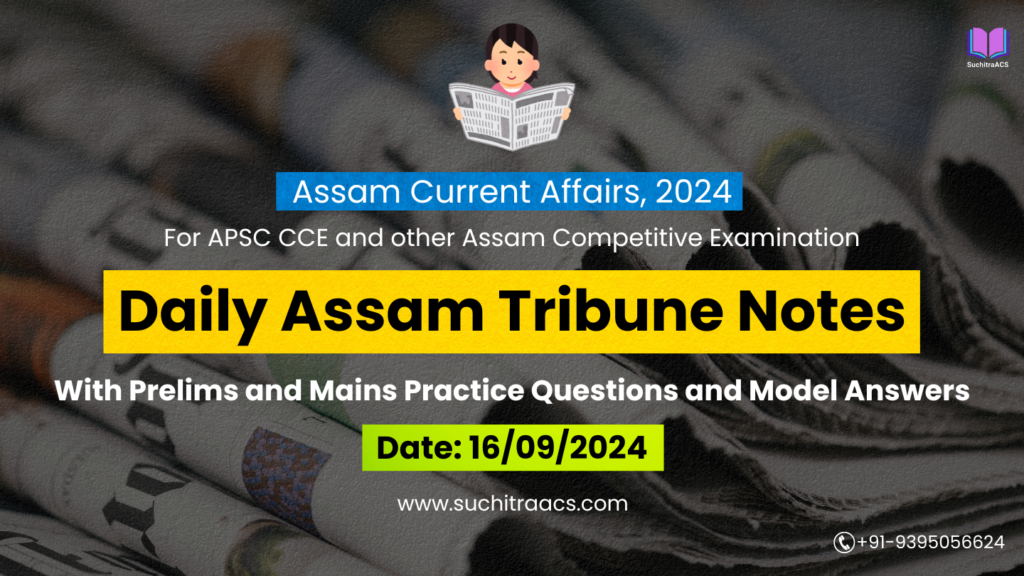APSC Current Affairs: Assam Tribune Notes with MCQs and Answer Writing (05/10/2024)
For APSC CCE and other Assam Competitive examinations aspirants, staying updated with current affairs is vital. This blog covers most important topics from the Assam Tribune today (05-10-2024). These issues are key for both APSC Prelims and Mains preparation, offering insights into the APSC CCE Syllabus.
1. Rs 664-Crore Scheme for Assam’s Tea Industry
GS Paper III – Agriculture, Economy, and Industry
Introduction:
The Union Ministry of Commerce and Industry has approved a Tea Development & Promotion Scheme with a budget of ₹664.09 crore. The scheme aims to boost Assam’s tea industry, which is grappling with climate change and fluctuating global demand.
Key Points:
- Holistic Development: The scheme focuses on everything from plantation development to market support and technological innovation.
- Assistance to Tea Growers: Financial support will be given to large estates, SHGs, and FPOs to develop nurseries, upgrade quality, and enhance productivity.
- Climate Resilience: Given the climate-driven stresses on tea crops, the scheme will address pest and disease management and introduce climate-smart practices.
Prelims Focus:
- Tea Board of India: Its role in promoting and regulating the tea industry.
- Key elements of the Tea Development & Promotion Scheme.
Mains Focus:
- Economic Impact: How financial assistance under this scheme can help Assam’s tea industry recover from production losses due to climate change.
- Sustainability Measures: The importance of technological upgrades and climate resilience in ensuring long-term sustainability of tea plantations.
- Challenges:
- Managing pest infestations and diseases exacerbated by climate change.
- Improving market competitiveness in global markets, where prices remain volatile.
Conclusion:
The Tea Development & Promotion Scheme is a lifeline for Assam’s struggling tea industry, ensuring both short-term recovery and long-term resilience. By addressing critical issues such as climate impact and market expansion, the scheme supports the sustainable growth of one of Assam’s most important economic sectors.
2. World Teachers’ Day and Its Relevance
GS Paper II – Social Justice, Education
Introduction:
World Teachers’ Day, celebrated globally on October 5, honors the contributions of teachers in building societies. The 2024 theme, “The transformation of education begins with the teachers”, highlights the crucial role educators play, especially in the post-pandemic world.
Key Points:
- Teachers’ Contribution to Society: Teachers shape students’ critical thinking, creativity, and collaboration skills, which are essential for addressing modern challenges.
- Impact of COVID-19: The pandemic accelerated the need for virtual learning and technological integration in education. Teachers adapted to new methods of delivering education and supporting students.
- UNESCO Standards: World Teachers’ Day also emphasizes improving teachers’ working conditions and providing continuous professional development opportunities.
Prelims Focus:
- World Teachers’ Day: Its history, significance, and key themes.
- ILO/UNESCO Recommendations on Teachers’ Status.
Mains Focus:
- Educational Transformation: The role of teachers in transforming education in the 21st century.
- Challenges for Educators: The need for better training, infrastructure, and working conditions for teachers, especially in under-resourced areas.
- Suggestions:
- Enhanced government support for teacher training and development.
- Integration of technology in classrooms to ensure accessible, modern education for all.
Conclusion:
World Teachers’ Day 2024 serves as a reminder of the indispensable role teachers play in shaping future generations. Recognizing their contributions and ensuring they have the resources they need is vital for educational success and societal progress.
3. Tea Industry Struggles with Climate Change and Pest Infestation
GS Paper III – Environment, Agriculture, and Industry
Introduction:
Assam’s tea industry is reeling from the effects of climate change and pest infestations, leading to a significant drop in production. Data from the Tea Board of India shows that Assam experienced an 11% production drop up to July 2024, with more losses expected due to September’s drought-like conditions.
Key Points:
- Pest Infestation: Tea estates have reported severe outbreaks of pests like Helopeltis, Looper Caterpillar, and Green Fly.
- Impact on Production: Prolonged dry periods followed by intense rains have weakened tea bushes, making them more susceptible to diseases.
- Market Impacts: Although there has been a 15% price increase, it is insufficient to cover the loss of crop quality and reduced export demand.
Prelims Focus:
- Tea Pests: Helopeltis, Looper Caterpillar, Green Fly, and their effects on tea production.
- Climate change impacts on Assam’s tea industry.
Mains Focus:
- Climate Adaptation: The urgent need for climate-resilient agriculture and integrated pest management practices.
- Economic Sustainability: How fluctuations in production and pricing affect the tea industry’s long-term profitability.
- Solutions:
- Investing in pest-resistant tea varieties.
- Providing farmers with early warning systems for climate anomalies.
Conclusion:
The tea industry in Assam faces an existential threat from climate change and pest infestations. Developing climate-resilient practices and pest management strategies is essential for ensuring the industry’s survival and growth.
4. Symposium on Northeast Economy: The Road Ahead
GS Paper III – Economic Development, Governance
Introduction:
A two-day symposium titled “Economy of Northeast India: The Road Ahead” was organized by the Omeo Kumar Das Institute of Social Change and Development (OKDISCD) in association with the North Eastern Economic Association (NEEA) to commemorate 25 years of the NEEA annual conference. The symposium aimed to address critical issues related to economic development in Northeast India.
Key Points:
- Focus on Regional Development: The symposium covered discussions on economic challenges and prospects for the region, including infrastructure, employment generation, and sustainable development.
- Policy Recommendations: Experts emphasized the need for policy reforms that cater to the specific economic landscape of Northeast India, highlighting issues like poor connectivity, lack of industrialization, and rural poverty.
- Collaborative Efforts: The conference advocated for greater collaboration between state governments, central agencies, and private stakeholders to boost regional growth.
Prelims Focus:
- Importance of Northeast India’s economy and its contribution to India’s overall development.
- NEEA and OKDISCD as key organizations promoting economic research and development in the region.
Mains Focus:
- Challenges for Economic Growth in Northeast India: The region faces infrastructural deficits, low industrialization, and lack of investments.
- Policy Interventions: The need for targeted policies focusing on infrastructure development, agriculture modernization, and boosting tourism.
- Sustainable Growth: Promoting green industries and renewable energy as the region’s geographical and environmental conditions make it suitable for such sectors.
Conclusion:
The symposium on Northeast India’s economy highlights the urgent need for focused interventions to accelerate economic development. Policies aimed at addressing infrastructural gaps and promoting sustainable industries can provide the region with a much-needed economic boost.
5. Assam’s Fresh Tender for Jorhat-Majuli Bridge
GS Paper I & III – Infrastructure, Geography
Introduction:
The construction of the Jorhat-Majuli Bridge has encountered significant delays due to the unwillingness of the original contractor to proceed. Chief Minister Himanta Biswa Sarma has announced that a fresh tender will be floated to expedite the project’s completion.
Key Points:
- Jorhat-Majuli Bridge: Spanning 8.25 km, the bridge will connect the river island of Majuli with the mainland, significantly improving connectivity for residents and promoting tourism and trade.
- Project Delays: Despite being launched in 2021 with a budget of ₹925.47 crore, the project has achieved only 30% progress, necessitating a fresh tender to ensure timely completion.
- Strategic Importance: Once completed, the bridge will reduce travel time and improve access to health, education, and employment for the people of Majuli.
Prelims Focus:
- The geographical importance of Majuli, the world’s largest river island.
- Key infrastructure projects in Assam, including the Jorhat-Majuli Bridge.
Mains Focus:
- Infrastructure Development: The role of major infrastructure projects like the Jorhat-Majuli Bridge in improving regional connectivity and economic growth.
- Challenges: Delays in project completion due to administrative and contractual issues, and the impact on local communities.
- Economic Impact: The potential boost in trade, tourism, and local industries once the bridge is operational.
Conclusion:
The Jorhat-Majuli Bridge is crucial for the development of Assam’s riverine communities. Accelerating its completion will bring immediate socio-economic benefits, transforming the lives of the people in and around Majuli.
APSC Prelims Practice Questions
1. Which of the following is a primary component of the Rs 664-crore Tea Development & Promotion Scheme for Assam’s tea industry?
(a) Financial assistance for establishing new industrial zones
(b) Technological intervention and research for tea production
(c) Subsidies for oil and gas exploration in tea garden areas
(d) Replacement of tea with coffee plantations
Answer: (b) Technological intervention and research for tea production
Explanation:
The Tea Development & Promotion Scheme focuses on key areas such as plantation development, technological intervention, market support, and capacity building for Assam’s tea industry. It aims to strengthen the sector through research and technological upgrades, especially in areas like soil testing and organic certification.
2. What is the key environmental benefit of the Green Assam Initiative?
(a) Promotion of mining in forest areas
(b) Increasing Assam’s green cover to mitigate climate change
(c) Expansion of urban housing in forest regions
(d) Development of commercial zones within protected forests
Answer: (b) Increasing Assam’s green cover to mitigate climate change
Explanation:
The Green Assam Initiative focuses on increasing the state’s green cover through large-scale afforestation to combat climate change. The initiative promotes the planting of indigenous species to restore degraded lands and sequester carbon, thereby contributing to climate resilience.
3. Which of the following issues did the Gauhati High Court highlight regarding the 2016 APSC recruitment process for District Malaria Officer posts?
(a) The examination was conducted without proper question papers
(b) The evaluation process involved altering original marks in the viva voce
(c) The selection was based on a lottery system
(d) The candidates were selected without any written examination
Answer: (b) The evaluation process involved altering original marks in the viva voce
Explanation:
In a landmark judgment, the Gauhati High Court set aside the selection process for the District Malaria Officer posts after discovering that the original marks awarded in the viva voce were altered in the evaluation process, raising concerns about the fairness and transparency of the selection process.
4. What is one of the major challenges for Assam’s tea industry, as mentioned in the Tea Development & Promotion Scheme?
(a) Excessive reliance on fossil fuels
(b) Climate change and pest infestation affecting productivity
(c) Lack of demand for tea in international markets
(d) Shortage of labor in tea estates
Answer: (b) Climate change and pest infestation affecting productivity
Explanation:
Assam’s tea industry faces significant challenges from climate change and pest infestations, which have led to reduced productivity and quality. The Tea Development & Promotion Scheme addresses these challenges by promoting climate-resilient practices and technological upgrades.
5. The Jorhat-Majuli bridge project was delayed primarily due to which of the following reasons?
(a) Lack of government approval
(b) The contractor’s unwillingness to proceed
(c) Lack of funds
(d) Local protests against construction
Answer: (b) The contractor’s unwillingness to proceed
Explanation:
The construction of the Jorhat-Majuli bridge was delayed as the original contractor, the UP State Bridge Construction Corporation Limited, was unwilling to proceed with the project. The government is now considering issuing a fresh tender to ensure the completion of the project.
APSC Mains Practice Question
Question:
Discuss the significance of Assam’s tea industry in the state’s economy and the challenges it faces in the wake of climate change and market volatility. What measures have been proposed under the Rs 664-crore Tea Development & Promotion Scheme to address these challenges?
(Answer in 250 words)
Model Answer:
Introduction:
The tea industry is central to Assam’s economy, contributing significantly to both employment and export revenue. Assam produces more than half of India’s tea, making it a key player in the global tea market. However, the industry is grappling with multiple challenges, including climate change, pest infestations, and price volatility in international markets.
Significance of Assam’s Tea Industry:
- Employment: The tea industry employs nearly 1 million people in Assam, with many working in plantations and related sectors.
- Revenue Generation: Tea is a major export commodity, contributing to foreign exchange earnings and the state’s economic stability.
- Cultural Heritage: Tea cultivation is intertwined with Assam’s cultural identity, with Assam Tea being one of the most recognized teas globally.
Challenges:
- Climate Change: Unpredictable weather patterns and droughts have led to crop failures and reduced production.
- Pest Infestations: Increased pest attacks, such as Helopeltis, have further exacerbated the production challenges.
- Market Volatility: Fluctuating global prices and declining demand have affected profitability, with many small tea growers struggling to compete.
Measures under the Rs 664-Crore Tea Development & Promotion Scheme:
- Plantation Development: The scheme supports replanting efforts and nursery development for SHGs and FPOs.
- Technological Upgradation: Financial assistance is provided for quality enhancement and climate-resilient practices.
- Market Promotion: Efforts to improve both domestic and global branding are key components of the scheme to boost sales.
- Worker Welfare: The scheme includes initiatives aimed at improving welfare and capacity building for tea garden workers.
Conclusion:
Assam’s tea industry is facing significant challenges, but the Tea Development & Promotion Scheme aims to address these issues through a comprehensive approach that includes replanting, technological advancements, and market support. With the successful implementation of these measures, Assam’s tea sector can recover and continue to contribute to the state’s economic growth.
✨ Looking for top-quality APSC online coaching at an affordable price?

🔔 Join Our WhatsApp Study Group!
For exclusive access to premium quality content, including study materials, current affairs, MCQs, and model answers for APSC CCE and other Assam competitive exams.
Click here to join: SuchitraACS Study WhatsApp Group
📚 Want to know more about SuchitraACS’s most affordable courses?
Click here to know more: SuchitraACS Courses for APSC CCE and Assam Competitive Examinations




